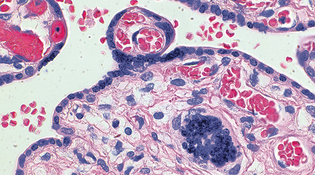 loading
loading
FindingsAn early diagnosis for autism?Clues are found in the placenta of newborns.  Harvey KlimanThe deep violet trophoblast inclusion in this placental cross section may be a marker of something that has gone wrong. View full imageThe key to early diagnosis of children at risk of developing an autism spectrum disorder (ASD) may be their placentas. Currently, most children affected by ASD can’t be diagnosed before the age of three. Yet research shows that the earlier caregivers begin teaching these children social skills, the better. Now, Harvey J. Kliman of the Yale medical school has pioneered a technique that he says can identify infants at risk as soon as they’re born. Kliman and his team analyzed 217 placentas, 117 of which were from known at-risk pregnancies. Mothers who have already had one ASD child are ten times more likely to give birth to another, and the study found that the placentas of these ASD siblings were almost eight times more likely to have significantly more of the microscopic folds and creases known as trophoblast inclusions (TIs) than other children’s. “TIs are a marker of something that has gone wrong genetically,” says Kliman, who directs the School of Medicine’s Reproductive and Placental Research Unit. The work was published in the online edition of Biological Psychiatry. From each placenta, the team examined four slides under the microscope. They found that among women with no ASD offspring, no sample had more than two inclusions. But if a sample had four or more inclusions, there was an “almost 100 percent chance” that the children were in the at-risk group. Kliman emphasizes that it’s too early to tell whether the at-risk children in the study would eventually be diagnosed with ASD. “We’ll know in about two years,” he says. But he adds that there’s no downside to early intervention. “No child has ever been hurt by having a parent or teacher spend extra time with them.”
The comment period has expired.
|
|